|

Material compiled by Project FMM
Research Team
3-29-2007
from
Rense Website
Contents
PROJECT FMM Fiber, Meteorite & Morgellons
PHASE IA
Initial Examination of Several Dozen Samples
March 29, 2007
Principal Researcher Dr. Hildegarde Staninger, RIET-1
INTEGRATIVE HEALTH INTERNATIONAL, LLC
12235 Centralia Street, Lakewood, CA 90715
Tel: 562-402-7300 Fax: 562-402-7308 Direct: 213-382-2786
Project Contract Labs: AMDL, Inc., ACS, Inc., MIT, and Lambda
Solutions, Inc.
PHASE IA Samples from Sept. 1, 2006.
Results Received February 5, 2007
Subject Samples of Unknown Fibers Collected form Many Sources and
Delivered to Laboratory.
Report of: Examination, Microscopic Measurements and Spectrographic
Analysis of Several Dozen Fibers Sent from IHI, LLC, Lakewood, CA.
INTRODUCTION
Several batches of unknown suspect fibers were sent to the
laboratory over a period of several weeks. We were asked to examine
them, study them microscopically, determine some physical
properties, and run elemental analysis by energy dispersive
spectroscopy (EDS) and chemical groups by Fourier transform
infrared spectroscopy (FTIR). Also some samples would be
analyzed by Fourier transform Raman spectroscopy (FT-Raman).
Laboratory personnel would also compare the fibers with some other
nanofibers reported to be carbon-silicon fibers with
photo-luminescent and other properties.
NOTE: All Samples were compared to the "Goldenhead" as found by Dr.
Rahim Karjoo and Dr. Hildegarde Staninger (October 28,
2006) and a fiber that was identified as High Density
Polyethylene Fiber (HDPE).
RESULTS
1) Visually a few of the fibers
resembled the carbon-silicon fibers previously studied by
Integrative Health International, LLC.
2) Close-up photos and photomicrographs (1,000 x) were taken
of most samples.
3) Many strange shapes and lumps were seen and some could
not be identified.
4) Identification of the photomicrographs were identified to
contain a "foreign fiber" or not. These fibers were then
selected for further testing and melting points.
5) A FTIR spectrum of one spot on the fiber indicated the
presence of high density polyethylene fiber plus a trace of
another material (brown gel).
6) EDS and Raman results will be discussed in Phase II and
Phase III of this report.
SUMMARY
The fibers identified, gel material, and gel shaped materials had no
cellular integrity with no eukaryotic cells. The materials
identified in the fibers were of a manufactured
nano technology to
form a specific structure with an undetermined function. The
chemical composition of fibers that had EDS and Raman did not match
the chemical composition of the human body nor were they any part of
the human body (nails, hair, skin, nerves, etc.).
Special features as identified by Los Angeles County Fire
Department, Los Angeles, CA personnel are the following: 1) skin
melts or burns at above 165 degrees F; 2) fibers from a human body
that do not melt at 1,400 degrees F or above 165 degrees are not
made of human cells; and 3) human tissue does not secrete gels nor
would they be of known human cellular composition that melt above
300 degrees C (i.e. approximately over 600 degrees F).
All samples that did have a fiber that matched nanotechnology as
compared to the original "Goldenhead" was identified as a "Morgellon
Like Fiber":
1) discarded Morgellon Goldenhead
2) fully formed Morgellon Goldenhead
3) deteriorating Morgellon Goldenhead
The
structured material/fibers identified were ones that would have
properties to self assemble, enlarge, and/or fold/expand. They were
identified as nanotechnology (man-made)1 and were not identified in
any way to be composed of eukaryotic cells, animal, plant, nor
composed of any live biological form.
Some specimens had "biological
artificial" appearances that are known as artificial life or
pseudo-life forms. These types of artificial life forms are known to
use DNA/RNA/siRNA or sRNA plasmid templates of viruses,
microorganisms, animal/plant proteins and/or enzymes to build the
artificial technology structural form at nano level. Furthermore,
they are not limited to only these referenced life forms plasmids,
enzymes, and/or proteins.
Dr. Hildegarde Staninger
RIET-1, Principal Investigator, IHI, LLC
Dept. Research & Dev.
Industrial Toxicologist/IH & Doctor of Integrative Medicine
Footnotes
1 - Man-Made means not made by
nature or found in nature -
Morgellons Photos, Special Program #6,
Page Three of Five
L/N 12938/1
(See Phase III B for
detail)
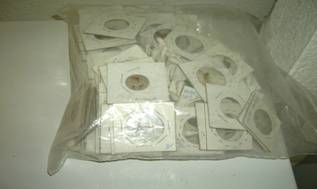
VARIETY

L/N 12938/2
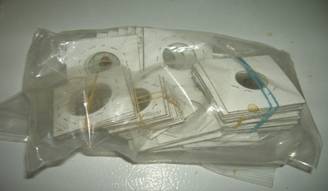
12939/2
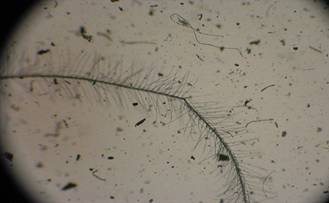
L/N 12938/3

SLIDE No 12

SEM/EDS Elemental Spectrum
(Image Scanned at 100X
missing from online file)
|
Atomic % |
Conc |
|
|
|
Na |
Ka |
16.145 |
12.273 wt.% |
|
Al |
Ka |
18.274 |
16.304 |
|
P |
Ka |
18.961 |
19.420 |
|
S |
Ka |
33.403 |
35.419 |
|
Cl |
Ka |
6.098 |
7.149 |
|
Ca |
Ka |
7.120 |
9.435 |
|
|
|
100.00 |
100.000 wt% |
|
L/N 12938/4
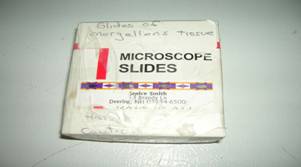

(No Data)
L/N 12938/5
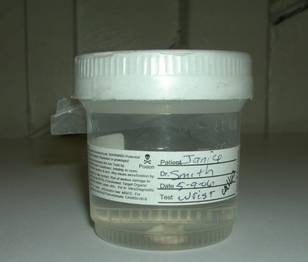
CALLUS
Negative for specific fiber configuration.
L/N 12938/6
Morgellons Tissue Samples in Alcohol
New lesion on left breast. Many particles were of gelatinous glowing
blood.
Fiber samples including striated strands.

(No data)
L/N 12938/6
Morgellons Tissue Samples in Alcohol
New lesion on left breast. Many particles were of gelatinous glowing
blood.
Fiber samples including striated strands. One particle

L/N 12938/7 - PR FRESS (Meteorite) See Phase III B Report for
detail
L/N 12938-B1 thru L/N 12938-B10 - Ten more specimens were examined,
photographed and found negative for specific fiber configuration.
PROJECT FMM PHASE I-B
(Fibers, Meteorite & Morgellons)
PROJECT FMM (FIBER, METEORITE & MORGELLONS)
Phase I - B Identification of High
Density Polyethylene (HDPE) Fiber
from "BB" a patient at IntroCell,
Pensacola, FL. Specimen collected by a Health Advocate
Samples From September 1, 2006
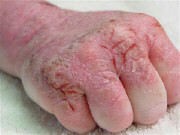  

SAMPLES FROM "BB", 8-14-06 Caution:
Biohazard Threat. Not sure (if there's fiber) but it fell off of her
leg

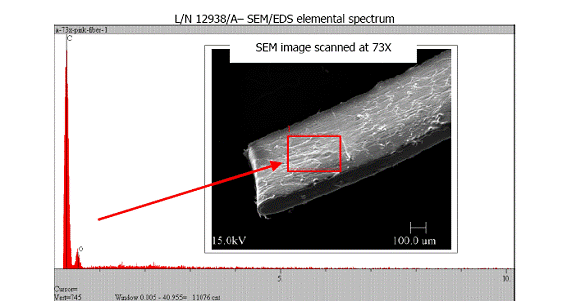
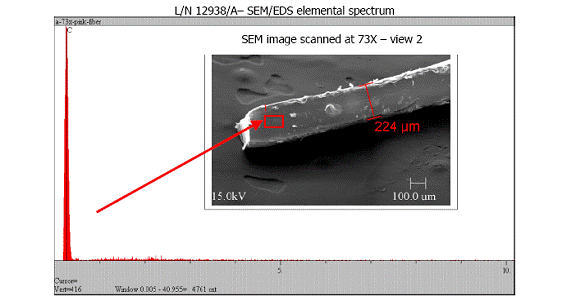
L/N 12938A FT-IR Spectral Overlay
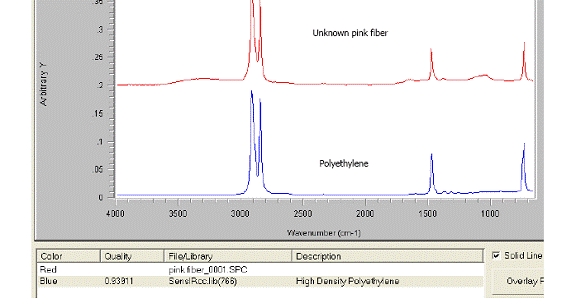
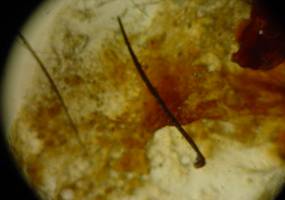
L/N 12938-1 (square slides) for
comparison
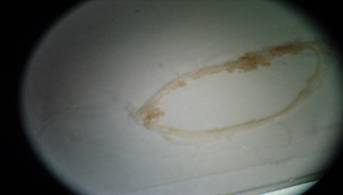
L/N 12938-3 for comparison
Back to Contents
PROJECT FMM (FIBER, METEORITE & MORGELLONS)
PHASE I-B
High Density Polyethylene, & Further Analyses
Principal Researcher: Dr.
Hildegarde Staninger, RIET-1
Saturday, September 1, 2006
INTEGRATIVE HEALTH INTERNATIONAL, LLC
12235 Centralia Street, Lakewood, CA 90715
Tel: 562-402-7300 Fax: 562-402-7308 Direct: 213-382-2786
Project Contract Labs: AMDL, Inc., ACS, Inc., MIT, and Lambda
Solutions, Inc.
PHASE I (Part B) Samples from Sept. 1, 2007.
Results Received: February 5, 2007
Subject: Samples of Unknown Fibers Collected form Many Sources and
Delivered to Laboratory.
Report of: Examination, Microscopic Measurements and Spectrographic
Analysis of
Several Dozen Fibers Sent from IHI, LLC, Lakewood, CA.
INTRODUCTION
Several batches of unknown suspect fibers were sent to the
laboratory over a period of several weeks. We were asked to examine
them, study them microscopically, determine some physical
properties, and run elemental analysis by energy dispersive
spectroscopy (EDS) and chemical groups by Fourier transform infrared
spectroscopy (FTIR). Also some samples would be analyzed by
Fourier
transform Raman spectroscopy (FT-Raman).
Laboratory personnel would also compare the fibers with some other
nano-fibers reported to be carbon-silicon fibers with
photoluminescent and other properties.
NOTE: All Samples were compared to the "Goldenhead" as found by Dr.
Rahim Karjoo and Dr. Hildegarde Staninger (October 28, 2006) and a
fiber that was identified as High Density Polyethylene Fiber (HDPE).
The following results specifically address the tests performed on
the High Density Poly-ethylene (HDPE) fiber from a patient of Dr.
Staninger's whom she consulted with at IntroCell, LLC, Pensacola,
FL. The specimen sample was from a piece of skin that fell from "BB's"
foot Sample No. 12938-A. Sample No. 12938-1 and 12938-3 will be
addressed for SEM/EDS data.
RESULTS
1) Visually a few of the fibers
resembled the carbon-silicon fibers previously studied by
Integrative Health International, LLC.
2) Close-up photos and photomicrographs (1,000 x) show the
pink fiber to the left of picture of Sample No. 12938-A.
3) A FTIR spectrum of one spot on the fiber indicated the
presence of high density polyethylene fiber plus a trace of
another material (brown gel). Fiber size 0.8 um and a
melting point of 115 degrees C.
4) SEMS/EDS results show various concentrations as stated
below
Sample Number 12938, % composition
|
A
|
1 |
3 |
|
|
Element Found |
"BB" |
Square Slides
|
JS
|
|
Sodium
(Na)
|
- |
3.510
|
16.304
|
|
Aluminum
(Al)
|
- |
18.961 |
19.420 |
|
Sulfur
(S)
|
- |
72.331
|
35.419
|
|
Chloride
(Cl)
|
- |
12.075
|
7.149
|
|
Ca |
- |
7.120 |
9.435 |
|
Copper
(Cu) |
- |
1.990
|
- |
|
Calcium
(Ca) |
- |
0.980 |
9.435 |
|
Phosphorous (P) |
- |
- |
19.420 |
|
Carbon,
C |
yes |
yes |
yes |
|
Oxygen
(O) |
yes |
yes |
yes |
|
HDPE,
fiber |
yes |
carbon/silica |
No |
|
Melting
Point, oC |
115 |
None
Stated |
None
Stated |
|
|
SUMMARY
The fibers identified, gel material, and gel shaped materials had no
cellular integrity with no eukaryotic cells. The materials
identified in the fibers were of a manufactured nano-technology to
form a specific structure with an undetermined function. The
chemical composition of fibers that had EDS and Raman did not match
the chemical composition of the human body nor were they any part of
the human body (nails, hair, skin, nerves, etc.).
Special features as identified by Los Angeles County Fire
Department, Los Angeles, CA personnel are the following 1) skin
melts or burns at above 165 degrees F; 2) fibers from a human body
that do not melt at 1,400 degrees F or above 165 F degrees are not
made of human cells; and 3) human tissue does not secrete gels nor
would they be of known human cellular composition that melt above
300 degrees C (i.e. approximately over 600 degrees F).
-
Sample 12938-A "BB"
The specimen shows carbon and oxygen present with the EDS test.
The other elements were to minimal to be detected. The specimen
was tested with Raman Test and found to be High Density
Polyethylene Fiber (HDPE) with a trace of another compound. The
other compounds have not been identified. Its Melting Point is
115 degrees C with a 0.8 um length.
-
Sample 12938-1 "Square Slides"
The specimen had no calcium present but did have high amount of
sulfur with trace copper. It did contain sodium, aluminum, and
chloride. These are all used as a battery or catalyst in
creating a battery similar to the Edison Cell or Lead Cell.
Edison cell type batteries utilize iron, potassium hydroxide,
and nickel oxide, while a lead cell type uses
Lead, lead oxide, lead sulfate and hydrogen sulfate. Note copper
in this sample. A compound known as chalcopyrite, CuFeS2 is
roasted in an air process to create copper sulfate, iron oxide
and sulfuric acid. When sand (silicon dioxide, SiO2) is added a
low melting point occurs and produces iron silicate. Copper is
very oxidative with various stages, but in its cupric copper
stage a blue color is obtained when it is contained within 4 to
5 water molecules (CuSO4 . 5H2O. The blue color of this solid is
due to the Cu+2 ion hydrated by four of the five water molecules
in a surrounding square planner arrangement.
-
Specimen 12938-3 "JS"
JS has submitted previous samples and did have the "Goldenhead"
identified in her samples with a melting point of above 1400
degrees F by Toxicological Pathology studies of Dr. Hildegarde
Staninger and Dr. Rahim Karjoo.
Sodium is present with significant aluminum, phosphorous and
primarily sulfur. Chloride is present with calcium. Calcium was
not present in 12938-1, while copper was present.
Sulfur was 35.419 % in this specimen and 72.331 % in Sample No.
12938-1 ("Square Slides"). All of the transitional elements and
other halogens are reactive or establish various valence stages
when exposed to water. It is believed that these elements using
the bio terrain they are in as their resource for building
materials utilize various to develop into various fibers and
other artificial nano life forms. It is very important to note
any amount of cupric ion is toxic to lower organisms, so it is
used to suppress the growth of algae in ponds and fungi and
molds on vines. Bordeux mixture used to spray grapes and
potatoes is made of copper sulfate and lime.
Calcium carbonate (which has been made into double walled nano
tubes with carbon), CaO3, decomposed upon heating to form carbon
dioxide gas, CO2 and calcium oxide (lime), CaO: + under a vacuum
at 800 degrees F. If not done under a vacuum other compounds can
from such as methane, oxygen, carbon dioxide and water. It may
be noted that in ALL of the samples (ChemTrail, 12938-A, and -1)
any sample with calcium and oxygen may have originally been
calcium carbonate and lime. The samples with copper, sulfur,
calcium and oxygen may have been similar compounds such as
Bordeux mixture but at a nano-scale level. These statements are
based on the data received and history of a burning glass needle
injection feeling by some Morgellon individuals.
A future question would be what is
keeping these nano-materials at equilibrium and what is their life
expectancy under "normal" and "varying" conditions.
Dr. Hildegarde
Staninger
RIET-1, Principal Investigator, IHI, LLC Dept. Research &
Dev. Industrial Toxicologist/IH & Doctor of Integrative Medicine
Footnotes
1 Man-Made means not made by
nature or found in nature.
Silica Nanotubes Based on
Needle-like Calcium Carbonate: Fabrication and Immobilization
for Glucose Oxidase, Ind. Eng. Chem. Res., 46 (2), 459 -463,
2007. 10.1021/ie060935+ S0888-5885(06)00935-3,
http://pubs.acs.org/cgi-bin/abstract.cgi/iecred/2007/46/i02/abs/ie060935+.html
Web Release Date: December 15, 2006, Copyright © 2006 American
Chemical Society
Nanocyl 9000 Series Datasheet,
High Density Polyethylene Nanocomposite Powder
http://www.nanocyl.com/ecommerce/pdf/tech2.pdf
Back to Contents
PROJECT FMM (FIBER, METEORITE & MORGELLONS)
PHASE II -
CHEMTRAIL FALLOUT
Principal Researcher Dr.
Hildegarde Staninger, RIET-1
Saturday, March 27, 2007
INTEGRATIVE HEALTH INTERNATIONAL, LLC
12235 Centralia Street, Lakewood, CA 90715
Tel: 562-402-7300 Fax: 562-402-7308 Direct: 213-382-2786
Project Contract Labs: AMDL, Inc., ACS, Inc., MIT, and Lambda
Solutions, Inc.
PHASE II Samples from January 8, 2007
Results Received March 20, 2007
Subject: Three Samples of Unknown Suspect Fibers Delivered to
Laboratory.
Report of: Visual and Microscopic Examination and Spectrographic
Analysis of Suspect
Fibers Collected by Integrative Health International, LLC.
INTRODUCTION
Phase II consists of a second batch of unknown suspect fibers were
sent to the laboratory. They were asked to examine them, study them
microscopically, take photomicrographs, and to determine some
physical properties, and to run elemental analysis by energy
dispersive spectroscopy (EDS). They would also compare their
properties with those of other fibers such as nano-fibers, nano-tubes,
carbon-silicon nano-wires, meteroritic particles,
Morgellons and
carbon-silicon fibers.
RESULTS
-
The samples were a collection of
three specimens collected by an individual in Texas. These
specimens were falling from the sky after a Chemtrail spraying
in the area. The specimens streamed from the sky like spider
webs and landed on the plants, grass and back yard of the
individual. A stick was used by the individual to collect the
specimens. They were then placed in a plastic ziplock bag and
saved for future analysis. These specimens were submitted to IHI,
LLC for analysis under Project: FMM. The specimens received
appeared to be like a clump of 3 white spider webs or white
cotton candy. Meteorite fibers findings reported in Phase III of
PROJECT: FMM.
-
These fiber samples resemble some of
the previously submitted fibers but not the Morgellon's "Goldenhead",
which we will call a primary reference figure. They do resemble
a Morgellon's "Goldenhead" that is either 1) not fully
developed; 2) being discarded or 3) deteriorating. Note the
shape and the SEMs picture of the standard silicon based
nanotube/wire that has the "memory" shape of a tongue that is
bent down/up (due to position of reference).
-
EDS data for the three fiber samples
show the presence of six elements: sodium, aluminum, phosphorus,
calcium, sulfur and chlorine, which could be due to natural
mineral fibers. Further testing by Raman in Phase III shows they
were nanotechnology (man-made structures).
-
EDS data does have carbon and oxygen
present for all samples. The carbon and oxygen was taken out of
the total percent composition so a total percentage of trace
elements could be identified. The elements identified were
transitional elements. Transitional elements are known for their
high magnetism and valence charge. They are used in making
electro-magnetic batteries. (Further discussion of batteries in
separate document.)
-
Sample 13263-1 has within its
nanotube an outline of a pre-Morgellon like structure known as "Goldenhead".
Note the extremely high amount of calcium 69.994%, sulfur 1.517
%, chlorine 18.129%, potassium 5.559% and iron 4.801%, and NO
silica. Note the outline of a "Goldenhead" with distinct
features of a muzzle like a wolf at 3 o'clock. SEM is at 1,500x
and scale of 20 microns.
-
Sample 13263-2 (no SEM picture).
Note the extremely high amount of potassium 30.222%, calcium
12.905%, iron 18.442%, sulfur 11.117%, chlorine 21.567% and
silica 5.767%. A general question of these EDS data as compared
to Sample 13263-1 is that the calcium makes the nanotube, thus
when it breaks down by the surrounding bio terrain, it will
produce a carbon-silica nanowire or a silica wire.
-
Sample 13263-3 (no SEM picture).
Note the extremely high amount of iron 41.515%, silica 12.999,
sulfur 8.791%, chlorine 16.403%, potassium 13.406% and calcium
6.885%. If silica percentage rising 12.999% as compared to
Sample 13263-1 then a more defined carbon-silica or silica wire
is being formed. The high value of iron 41.515%, sulfur,
chloride, potassium in the presence of oxygen to form iron
oxides and other transitional oxides/ -OH an electro-magnetic
continuous electrical cell could be formed which would be
commonly known as a "battery".
The higher developed pre
Morgellons
"Goldenhead" would then not need a nanotube but would be allowed
to move within the body freely, especially under the skin. A
paper written by Marcus Mighty, Nanorobot Mechanocompatibility,
Department of Mechanical Engineering and Energy Processes,
Southern Illinois University at Carbondale © May 5, 2005:
-
(http://www.engr.siu.edu/mech/faculty/hippo/ME465SP05mightyPaper.doc)
clearly states that the problem with nanorobotic devices
is that as they pass through the skin they cause
excessive bruising, itching and other disturbances...
Nanorobots must be
mechanically able to withstand interaction not only with
other tissues and cells, but also other nanorobots
interacting within the body...
Nanorobots used in medical
monitoring are made of diamond and diamonoids (if
zirconia or liquid zirconia melting point 1,500 degrees
C to 3,000 degrees C)...
With nanorobots performing
various duties around the body, there would be reasons
to consider whether these nanorobots would cause
irritation around different areas of the body. One
irritation that the nanorobot could cause is excessive
itching. This could happen around areas such as the ears
or the mouth (or other orifices).
-
-
Specimen 13263-1 contained
36.167 % Carbon and 51.501 % Oxygen.
-
Specimen 13263-2 contained
48.486 % Carbon and 39.943 % Oxygen.
-
Specimen 13263-3 contained
47.267 % Carbon and 47.139 % Oxygen.
Note when carbon is in these ratios
and in the present of transitional elements with oxygen present
electro-magnetic cells are made and a reverse micelle reaction
could occur due to the interaction of the human cell and the
water present outside a cell (fresh) inside the cell (salt)
water. If this is occurring in these specimens once in the body
a high conductivity value will be observed.
SUMMATION
The specimens were collected and submitted to IHI, LLC by an
individual in Texas. The SEM images resemble a Morgellon like "Goldenhead"
within a nanotube. These three specimens were from fiber particulate
fall out after a Chemtrail spraying. These materials once on the
ground surface may be broken up into smaller pieces which may be
classified as nano-arrays, if each section functions as an
individual unit. These nano-materials can self-assemble, replicate
and enlarge.
Dr. Hildegarde Staninger
RIET-1, Principal Investigator Project: FMM
Industrial Toxicologist/IH & Doctor of Integrative Medicine
Footnote
1 Man-Made means not made by
nature or found in nature.
Texas Respondent, Chemtrail Droppings
Summer, 2006 (specifics on file)

L/N 13263-1
FIBER 1
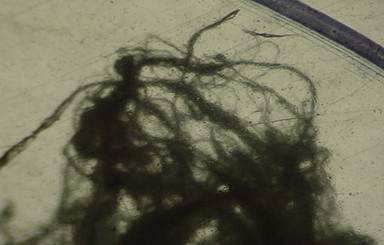

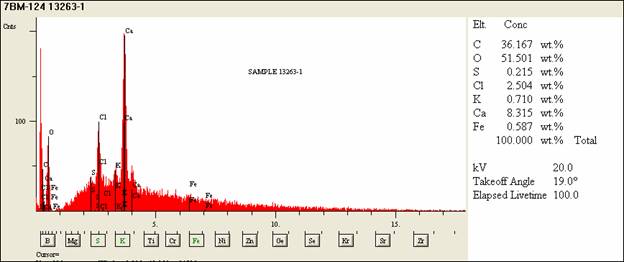
L/N 13263/2
FIBER 2
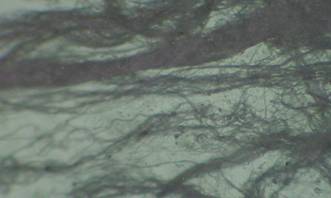
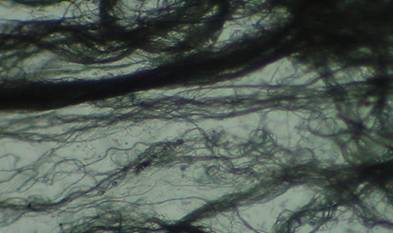

L/N 13263/3
FIBER 3

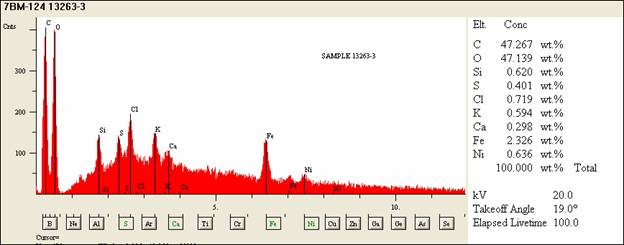
"Goldenhead"
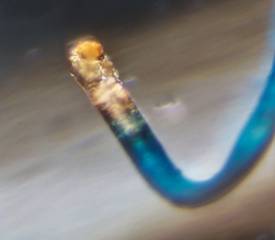 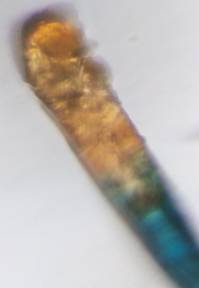 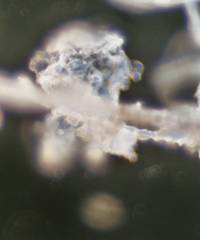
Back to Contents
PROJECT FMM (FIBER, METEORITE & MORGELLONS)
PHASE IIIA -
Morgellons Fibers Tested and Compared
Principal Researcher Dr.
Hildegarde Staninger, RIET-1
Saturday, March 27, 2007
INTEGRATIVE HEALTH INTERNATIONAL, LLC
12235 Centralia Street, Lakewood, CA 90715
Tel: 562-402-7300 Fax: 562-402-7308 Direct: 213-382-2786
Project Contract Labs: AMDL, Inc., ACS, Inc., MIT, and Lambda
Solutions, Inc.
PHASE III-A Samples from Jan/Feb 2007.
Results Received: March 20, 2007
Subject: Fourteen Samples of Unknown Suspect Fibers Delivered to
Laboratory.
Report of: Visual and Microscopic Examination and Spectrographic
Analysis of Suspect
Morgellon Fibers Collected by Integrative Health International, LLC.
INTRODUCTION
The laboratory received a third batch of suspect Morgellon fibers
associated with skin problems (and other health problems) in
individuals. They were asked to examine them, study them
microscopically, take photomicrographs, to determine some physical
properties, and to run elemental analysis by energy dispersive
spectroscopy (EDS). We would run several tests using Samples 13354-1
A & B, 13354-4 and 13354-10.
Laboratory personnel would also compare their properties with other
structures such as
Morgellons "Goldenhead", nanofibers, nanotubes,
carbon-silicon nanowires, meteroritic particles, polyethylene and
polyester fibers.
RESULTS
-
A majority of the 14 samples
resemble the previously submitted fibers as discussed in Phase I
and Phase II PROJECT: FMM Reports.
-
Some of the photomicrographs suggest
that the fibers are nanotechnology based as seen in SEMS and
4,000x 3D lens as used in Pathology.
-
Sample 13354-1 A and Sample 13354-1
B these samples were take from skin surface. Average specimen
size was 2 inches long by 1/8th inch wide.
These two specimens were next to each other and from "Anna".
Sample 13354 1 A percent composition was aluminum 1.558 %,
sulfur 70.670 %, chloride 21.086 %, calcium 3.308 % and iron
3.378 %. Carbon and oxygen were present, but extrapolated out to
determine concentrations of trace elements. Elements were
transitional elements. See Phase II Report.
Sample 13354 1 B percent composition was sodium 0.959 %,
silica 8.352 %, sulfur 11.219 %, chloride 6.568 %, calcium 4.200
%, iron 3.635 % and zinc 65.066 %.
When one compares these results to the Chemtrail results we note
that zinc and sulfur are extremely high. Aluminum was present
while sulfur was high in Sample 13354-1 A and sodium/silica was
present with high zinc in Sample 13354- 1 B. These results again
confirm the various stages of Morgellon "Goldenhead" like nano
structures.
No nanotube was observed due to low
calcium levels. Since the specimen sample was from the surface
and being pushed length wise out of the body are these total
percent compositions by weight reflective of the various stages
or life expectancy of this nanotechnology.
-
Sample 13354 4 were skin samples
with fibers from "Lily". Percent composition by weight was
sodium 4.276 %, silica 3.595 %, sulfur 4.088 %, chloride 27.828
%, potassium 26.843 %, calcium 16.494 % and iron 16.877 %.
When comparing this sample to "Anna's" there is no comparison.
Shape as shown in the SEM images are in various stages of
structural development. The transitional element percent by
weight composition is very different. "Lily's" has the above 10%
calcium, chloride and potassium present while "Anna's" had the
extremely high sulfur and zinc levels. Lily's were either newly
developed while Anna's were older and expelling from her skin
horizontally vs. vertically. "Lily's" had 3.595 % silica while
"Anna's" had no silica.
-
Sample 13354 10 were skin samples
with fibers from "Lily". Percent composition by weight was
sodium 3.133 %, silica 0.889 %, phosphorus 8.142 %, sulfur
29.393 %, potassium 12.909 %, calcium 10.709 % and iron 17.492
%. This sample has the presence of phosphorus, less silica and
potassium and similar levels of iron. The explanation may be
that the material that coats the carbon-silica or silica nano
wire may be covering the wire, thus EDS could not penetrate the
specimen or that different substances found in the bio-terrain
will produce various building materials for nanorobotic
assembling machines to perform their designed tasks.
It must be stated that in the Chemtrail samples, Anna's, Lily's
and previous samples from Jan Smith (pathology reports and 4,000
x 3 D photomicrographs all have the same "Goldenhead" shape. The
molecular nano composition of the elements used to make this
structure has a distinct smart technology or "memory" for that
structure. The principal being expressed with these specimen
samples are the same as the NASA designed memory foam. The foam
maintains its original shape and form. Therefore, the original
designer of this nanotechnology designed the technology to
maintain specific structural characteristics.
Note in Sample 13354- 10 at 12 Noon there is a distinct image of
a silica tongued nano tube.
-
Sample 13354 7 was a sample of
hair from "Lily." Dr. Staninger took the sample herself along
with a "pseudo hair" that popped out of the skin after spraying
das Wasser on the surface of Lily's right leg. The "pseudo hair'
grew 1/2 inch in less than one could count 1, 2, 3. The
importance of these specimens is that after core hair analysis
by the laboratory it was determined that both samples were not
human or animal hair.
Animal hair has a core, while filaments or hair like structures
from certain plants do not have a core. The core diameter varies
for a male, female and a child. This method of determining
whether a specimen is human, animal, or plant is done under
Forensic Analysis parameters. These specimens analysis was
performed to these criteria.
-
Sample 13354 13 was a specimen
submitted by a Lady from Oregon. The specimen did not appear to
have fibers but was composed of cream colored granules. These
specimens did not match any of the others discussed in Phase
III-A.
-
The melting point for Anna's Sample
13354 11 was 200 degrees C and Lily's Sample 13354 10 was
198 degrees C. The melting points are over 400 degrees F and
definitely above the melting point of the skin of a human being.
This also confirms the composition of these two types of
specimens are similar but in various stages of nano structural
development.
SUMMATION
Phase III of PROJECT: FMM clearly demonstrated the various stages
that a Morgellon-like "Goldenhead" could be at within the body,
externally and in transitional stages. It can be at a stage of being
disregarded, active or decomposing. All samples except 13354-13
(Lady from Oregon) matched all other sample specimens Morgellon
like "Goldenhead" or pre-"Goldenhead."
The samples of Anna and Lily had relative similar melting points
that were three (3) times greater than the temperature to burn or
melt human skin. SEMs and EDS confirm nanotechnology. It must be
noted that a second degree burn to human skin is at 165 degrees F.
The melting point of both Anna's and Lily's specimens were over 400
degrees F.
Lily's sample of regular and "pseudo" hair were determined to be
non-human or animal hair. Both specimens were "pseudo" hair. Future
research will determine the life expectancy or degradation
properties of nanotubes, nanofibers, and nanowires within humans,
plants, and/or animals as related to their environment. In addition,
the mechanism of "pseudo" hair and/or the general properties of
nanotechnology structures found within humans, plants or animals may
be may also be expressed as nanorobotic machines.
Further investigation as to the
comprehensive bio-nanotoxicological effects of any nanotechnology
when exposed to the life forms discussed in this paragraph must be
tested not only for their mechanocompatability properties, but for
their acute, chronic and systemic toxicological effects upon the
human body. The samples discussed in Phase I, II, III-A and III-B
are made from man-made nanomaterials and are definitely
nanotechnology. The specimens that were from individuals who have
the disease
Morgellons, do have various forms of
nanotechnology (nanotubes,
nanofibers, nanowires, or silicon gel/shapes) within their bodies.
These materials were designed for a specific purpose and function,
which is currently not known but will be understood by all in the
near future.
Dr. Hildegarde Staninger
RIET-1, Principal Investigator PROJECT: FMM
Industrial Toxicologist/IH & Doctor of Integrative Medicine
Footnote
1 - Man-Made means not made by
nature or found in nature.
L/N 13354/1
#1 'Anna' - Fibers+Skin Received 1/18/2007
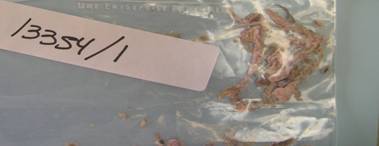
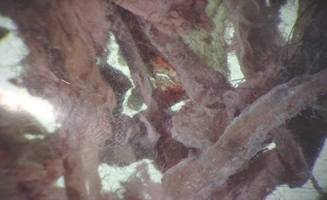
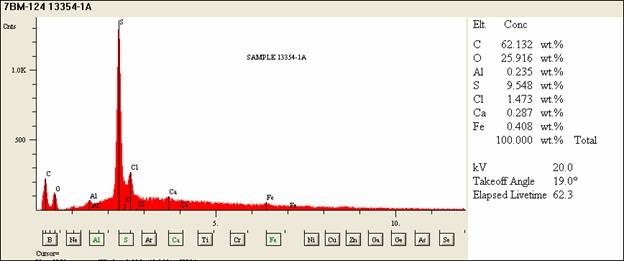
L/N 13354/1.1
'Lily' - #1.1- 01/18/2007
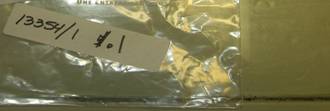



L/N 13354/3
'Lily' - #3 - 01/18/2007


L/N 13354/4
'Lily' - #4 - 01/18/2007
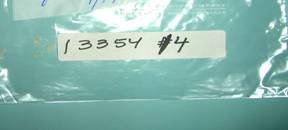
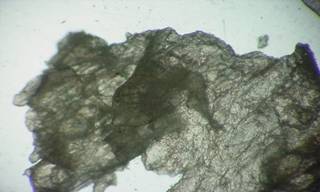

L/N 13354/10
'Lily' - #10 -01/18/2007
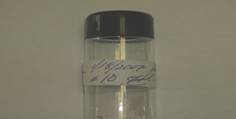

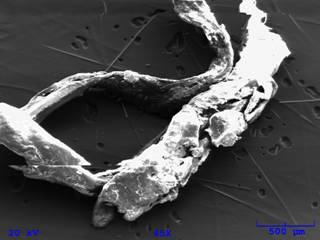
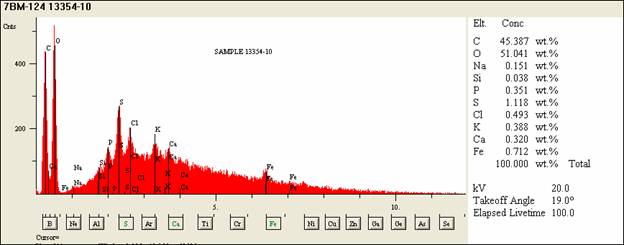
L/N 13354/7
Regular Hair received from 'Lily' Jan. 11, 2007- - #7 -
01/18/2007
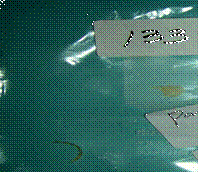

L/N 13354/8
'Lily' - #8 - 01/18/2007

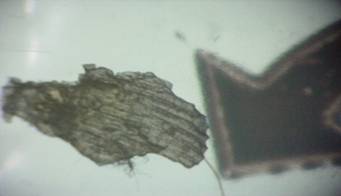
L/N 13354/9
'Lily' - #9 - 01/18/ 2007


L/N 13354/11
'Anna' - #11 - 01/18/2007


L/N 13354/12
'Anna' - #12 - 01/23/2007 Sample from left thigh

 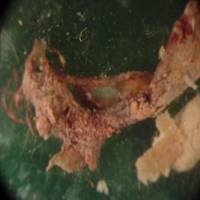
L/N 13354/13
Female Oregon - #13 - 01/23/2007


SEE ANALYSES FOR DETAILS ON SAMPLES WITH NO TEST RESULTS SHOWING.
Back to Contents
PROJECT FMM (Morgellons Fiber and
Meteorite Fibers)
PHASE III B
Raman
Principal Researcher Dr.
Hildegarde Staninger, RIET-1
Saturday, March 27, 2007
INTEGRATIVE HEALTH INTERNATIONAL, LLC
12235 Centralia Street, Lakewood, CA 90715
Tel: 562-402-7300 Fax: 562-402-7308 Direct: 213-382-2786
Project Contract Labs: AMDL, Inc., ACS, Inc., MIT, and Lambda
Solutions, Inc.
PHASE III-B Samples sent Sept. 2006.
Results Received March 20, 2007
Subject: L/N: 12938 A series of specimens. These are the RAMAN
TESTS.
Two Samples of Unknown Fibers were Collected from Two Sources and
Delivered to Laboratory.
Report of: Examination and Fourier Transform-Raman Spectra of Two
Suspects
Morgellon Fibers Sent by Integrative Health International, LLC.
Method: Fourier Transform Raman Spectroscopy (FT-Raman).
INTRODUCTION
Two similar samples (No. 12938-1 and No. 12938-7) of suspect fibers
were previously studied and reported in Phase I PROJECT: FMM Report.
In the present report various laboratories (Lambda Solutions, Inc.
and MIT's Woods Hole Oceanographic Institution) would analyze these
two samples by Fourier Transform Raman Spectroscopy to learn more
about their chemical structures. Both fibers were suspect
Morgellons
and would be examined for Raman structural groups to attempt
identification of the material(s). Sample No. 12938-1 would be sent
to Lambda Solutions, Inc. and Sample No. 12938-7 would be sent to
MIT's Woods Hole Oceanographic Institution.
Sample No. 12938-1 is described in Phase I Report as being square
slides with different particles. All specimens on slide appears to
be similar but do not appear to be carbon-silicon fibers. Raman Test
will confirm carbon-silicon or silica fibers. RI < 1.55 Dichroism:
Negative.
Sample No. 12938-7 is described in Phase I Report as a container
with fibers in rubber band and Labeled INC-7-19-06 PR FRESS. The
sample is from a meteorite. Specimen was tested for melting point.
No melting occurred but it darkened at 200 degrees with no dichroism.
RESULTS
-
Microscopically both fiber
samples have head and body features resembling typical
Morgellon fibers.
-
The FT-Raman spectra provided by
Lambda Solutions, Inc. (No. 12938-1) and MIT (No. 12938-7)
have vibrations from aliphatics and aromatics. In addition,
3.5 % silicon was present in one area.
-
The Raman spectra indicate the
presence of an organic polymer but did not identify it.
-
Lambda Solutions, Inc. gave a
verbal opinion that the plastic may be a copolymer of a
polyester and an aromatic.
LAMBDA Solutions, Inc. Specific Results
Samples
Samples were received on Friday, March 9, 2007. The samples were
fibers adhered by "tape" to the bottom of a glass slide and backed
with white paper. In order to analyze the samples, the white paper
was removed and the tape removed from the bottom of the glass. This
was necessary so that the silica in the glass did not serve as an
additional reflecting surface or to have the silica confound the
analysis. The samples were flattened by adhering the tape and fibers
to the non-glossy surface of Heavy Duty Reynolds Aluminum Foil.
Instrumentation
Analysis was carried out with a Dimension-P2 785 Raman Spectrometer
utilizing a Dimension-M1 micro Raman Adaptor mounted on a Nikon L150
microscope equipped with 10x and 50x Plan Fluor Epi Objectives.
Video images were captured with a Luminara CCD mounted on the Nikon
system. Illumination was by minimum light and laser beam. The
sampling of the laser with the "head" and "fiber" of the fiber
samples was performed.
The tape appeared to be Magic tape which is a form of Mylar
polyester. No silicon was found from the tape on the specimen.
The specimen's results had different compounds at different areas of
its structure.
1. Head small amount of silicon
present in head area of specimen, 3.5 % When compared to crystal
silica the "head" had little or NO silica.
2. Fiber- body adjacent to "head" showed polyester-like
substances that did not match the Magic tape composition of
Mylar polyester. Results suggestive of a co-polymer when Lambda
Solutions, Inc. was contacted by primary laboratory.
3. The "head" and 'fiber body" are composed of different
materials.
MIT Woods Hole Oceanographic Institution
Raman Laser System used was a 532 nm (Nd YAG (green) laser and a 10X
microscope objective with a power of approximately 20 mW which
slightly melted the fiber head (top edge). The laser power was
reduced to approximately 5 mW for all of the spectra obtained.
Spectra was collected from the shaft (spectrum 03120004), the edge
of the head (spectrum 03120005), and the middle of the head
(spectrum 03120006).
All of the spectra were dominated by
fluorescence. (Attempts to collect spectra in other locations
resulted in overwhelming fluorescence.)
1. The Raman bands that were
identified for Sample 12938-7 were:
2. No silicon was present.
3. MIT could not make "guess" as to what the fiber is made
of per staff.
SUMMATION
Raman Tests performed by Lambda Solutions, Inc. determined that the
fiber from Sample No. 12938-1 was composed of silicon ("head") with
little or no crystal silica present. The fiber ("body") was composed
of a polyester material. This material may be a co-polymer. No
fluorescence was stated for this sample. MITs Raman analysis
utilizing a different laser determined Sample No. 12938-7 was
dominated by fluorescence and was composed of aliphatic and aromatic
compounds. It also determined that a vibrational rate for Si-C was
present, which stands for silica carbide or silica-carbon. The
fluorescence is from the fiber and not from another source. The
fluorescence would be made of substances that fluorescence, which is
very similar to the way something glows in the dark.
Sample 12938-7 was composed of fibers from a Meteorite. The fiber
on the Meteorite did not match Sample 12938-1, which was from a
Morgellon's. The fibers identified in Sample 12938-7 do match
current nanotechnology that utilizes multilayer nano-tubes that are
made of plastic co-polymers and silica-carbon nano-tubes. Sample
12938-7 results do not match the composition of a meteorite nor does
a Meteorite fluorescence. The Meteorite sample appears to be
contaminated by a person who has
Morgellons
or has been exposed to nano-tubes made of silica-carbon or nanotechnology.
Dr. Hildegarde Staninger
RIET-1, Principal Investigator PROJECT: FMM
Industrial Toxicologist/IH & Doctor of Integrative Medicine
Footnote
1 - Man-Made means materials not
made by nature and not found in nature.
L/N 12938/1


L/N 12938/1 SEM Image Scanned at
30X


L/N 12938/7

1NC-7-19-06 PR FRESS

L/N 12938/7
FIBER FROM RUBBERBAND

( SEMS/EDS & GRAPHS WERE TOO DARK TO SCAN LAB
WILL PROVIDE BETTER COPY AT A LATER
DATE... AND WE WILL PROVIDE IT AT THAT TIME.)
See detail in Dr. Staninger's report above.
Back to Contents
|




































































